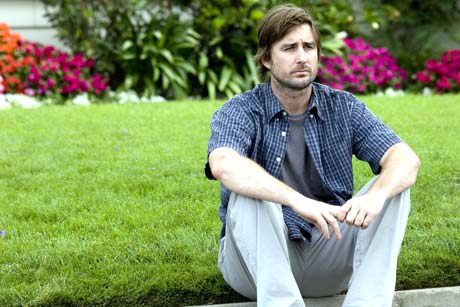To dismiss Henry Poole is Here as a maudlin rumination on faith and religion would be to ignore the inherent human struggles and blatant annihilation anxieties rumbling beneath the surface, which are exposed through the central "religious plot device that unites a group of diverse people. Faith acts as a simple fulcrum to expose incontrovertible feelings of disappointment, rage and lost hope.
Surface thematic interpretation aside, systemic cultural incertitude surrounding sincere emotions and the fear of complex mortal thoughts outside of the minutia that society is conditioned to value and prioritize will likely cause most to ignore Henry Pooles deeper human themes. This is a shame, as its one of the better films of 2008.
When he is unable to convince homeowners to sell a house he desperately wants, an angry and disconsolate Henry Poole (Luke Wilson) settles for a dilapidated house down the street. Settling into his routine of getting drunk by himself and eating frozen pizza, Henry is interrupted by an enthusiastic neighbour named Esperanza (Adriana Barazza), who believes a watermark on the side of his house to be the face of Jesus.
Given that Henry moved to the neighbourhood to be left alone, her bubbling persistence and endless religious prattle are particularly unwelcome and only complicated when he meets the mute daughter (Morgan Lily) of much more affable neighbour Dawn (Radha Mitchell). Through his newly established relationships, Henry is forced to battle the learned belief that hope and expectation beget pain and disappointment.
It is true that Albert Torress script paints subtlety like a four-year-old with an oversized crayon by imbuing central characters with names like "Dawn, "Patience and Esperanza (which means "Hope) and having them spout dialogue like "Hope wont save me, but Pellingtons direction of the material is rather impressive. He clearly understands despondency and defeat and frames his characters with emotional truth rather than the usual hip and ostentatious vulgarity.
Moments of stillness and reflection will be interpreted as either dull or moving, and as such will likely divide audience appreciation. Regardless, it would be difficult to ignore the visual cohesion and use of positioning and lighting to reinforce character representation.
This is a film that boils down human complexity to the basic anxieties that create conflict and has the balls to answer the question "Why? with "Why not?
(Seville)Surface thematic interpretation aside, systemic cultural incertitude surrounding sincere emotions and the fear of complex mortal thoughts outside of the minutia that society is conditioned to value and prioritize will likely cause most to ignore Henry Pooles deeper human themes. This is a shame, as its one of the better films of 2008.
When he is unable to convince homeowners to sell a house he desperately wants, an angry and disconsolate Henry Poole (Luke Wilson) settles for a dilapidated house down the street. Settling into his routine of getting drunk by himself and eating frozen pizza, Henry is interrupted by an enthusiastic neighbour named Esperanza (Adriana Barazza), who believes a watermark on the side of his house to be the face of Jesus.
Given that Henry moved to the neighbourhood to be left alone, her bubbling persistence and endless religious prattle are particularly unwelcome and only complicated when he meets the mute daughter (Morgan Lily) of much more affable neighbour Dawn (Radha Mitchell). Through his newly established relationships, Henry is forced to battle the learned belief that hope and expectation beget pain and disappointment.
It is true that Albert Torress script paints subtlety like a four-year-old with an oversized crayon by imbuing central characters with names like "Dawn, "Patience and Esperanza (which means "Hope) and having them spout dialogue like "Hope wont save me, but Pellingtons direction of the material is rather impressive. He clearly understands despondency and defeat and frames his characters with emotional truth rather than the usual hip and ostentatious vulgarity.
Moments of stillness and reflection will be interpreted as either dull or moving, and as such will likely divide audience appreciation. Regardless, it would be difficult to ignore the visual cohesion and use of positioning and lighting to reinforce character representation.
This is a film that boils down human complexity to the basic anxieties that create conflict and has the balls to answer the question "Why? with "Why not?
